Cosmic Curiosities
"A total eclipse of the Sun...is the most sublime and awe-inspiring sight that nature affords."
~ Isabel Martin Lewis, American Astronomer
Eclipse Saturdays
Preview and prepare for the big solar eclipse on August 21! Stop by the Planetarium on any of these three Saturdays: May 20, June 24, or July 29. We will have a host a fun events and activities, including:
- Stunning eclipse previews on the giant dome
- A massive shrunken Solar System display
- Sun-observing through special telescopes (clear skies permitting)
- Hands-on eclipse activities
- Printed eclipse guides for viewing the eclipse safely
Remember, folks -- do not look at the Sun directly. You need eye protection, and sunglasses are not strong enough to prevent eye damage! MPM will be selling eclipse glasses and will have telescopes with special filters to view the eclipsed Sun on August 21.
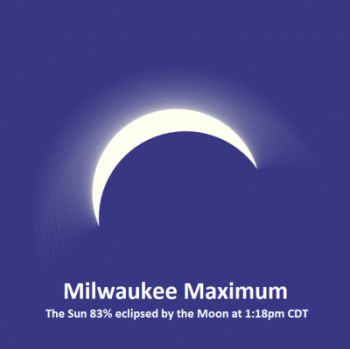 Milwaukee’s solar eclipse will be partial. About 83% of the Sun will disappear as the Moon crosses its face. At 1:18pm CDT, the Sun will look like a bright crescent Moon.
Milwaukee’s solar eclipse will be partial. About 83% of the Sun will disappear as the Moon crosses its face. At 1:18pm CDT, the Sun will look like a bright crescent Moon.
To witness the thrill and grandeur of 100% totality, you need to travel away from Wisconsin. Travel anywhere along the narrow path that stretches from Oregon to South Carolina. For exact locations, follow the thick yellow line on the USA map below. The Moon’s shadow path is only 70 miles wide, and our planet Earth is almost 8,000 miles wide! That’s a tiny eclipse path… This is why a total eclipse of the Sun is so rare.
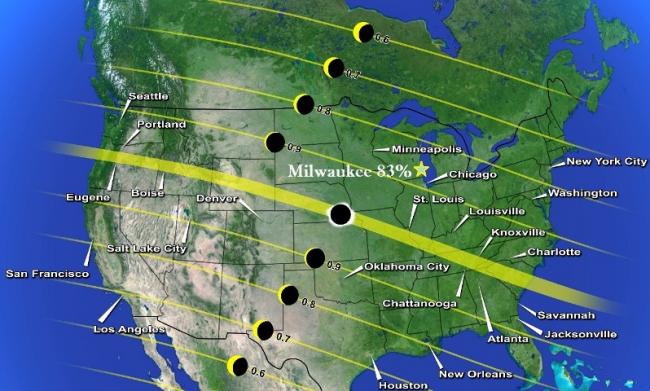
The celestial experience of totality is truly an once-in-a-lifetime event; the last total solar eclipse in Milwaukee was 1379, and it won’t happen again until 2099.
A Star by Any Other Name...
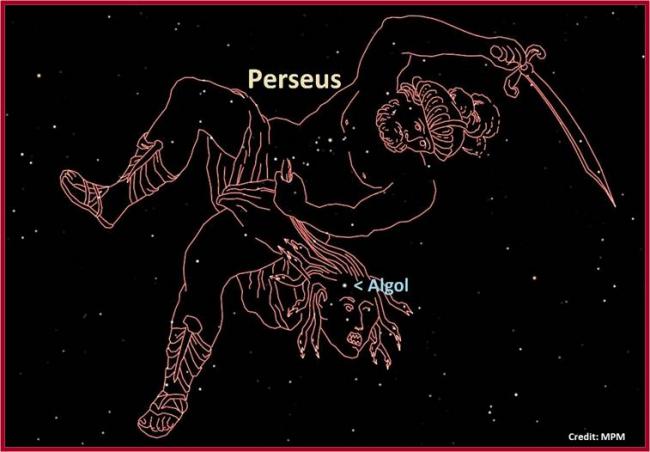
Shakespeare wrote in Romeo and Juliet, “What's in a name? That which we call a rose by any other name would smell as sweet.’’ Like roses, stars all work the same way. The Sun and all those distant points of light are immense nuclear furnaces converting one element into another and producing energy in the process.
But naming stars? Well, that’s on us. Naming things can be a rather quirky human endeavor. Star names grew out of the constellations and the stories they tell. The bright star Hamal in Aries the ram means “head of the ram.” Names can also reflect the star’s appearance. The star Algol varies its brilliance due to a companion star that eclipses its light. This brightening and dimming was unsettling, so the star was seen as a demon, ghost, and ogre. It also represents the mythical monster Medusa, who had snakes for hair. Another great example is Sirius. It's crazy bright, second only to the Sun. The name "Sirius" originates in Greece and means “scorching.”
 Of course, most cultures had their own names for the stars above them. Radiant Sirius in Sanskrit is Mrgavyadha, meaning "deer hunter," representing Rudra, praised as the "mightiest of the mighty." In Scandinavia, the star has been called Lokabrenna, translated as "burning done by Loki." Polynesians used Sirius for navigation. It was part of the large bird constellation called Manu.
Of course, most cultures had their own names for the stars above them. Radiant Sirius in Sanskrit is Mrgavyadha, meaning "deer hunter," representing Rudra, praised as the "mightiest of the mighty." In Scandinavia, the star has been called Lokabrenna, translated as "burning done by Loki." Polynesians used Sirius for navigation. It was part of the large bird constellation called Manu.
Today’s star names originated in the Middle East—their origins are mainly Greek, Arabic, and Latin. Since these cultures shared and mixed as travel increased, many star names originated in one area, and then were rewritten by another culture in their own language. For example, Arabic star names are very numerous. Many stem from al-Sufi, a 10th-century Persian astronomer who took many of the existing Greek or Latin star names and rewrote them in Arabic. They became very popular and survive as our modern star names.
Roughly 2,000 stars can be seen on a perfect, moonless night far from streetlights. But at present, only 240 stars have individual names. All the others use catalogue numbers and letters. For example, the star near where we found the first exo-planet is called Pegasi 51. Other designations are: GJ 882, HR 8729, BD +19°5036, HD 217014, LTT 16750, GCTP 5568.00, SAO 90896, and HIP 113357.
Below is a fun “A to Z” list of 26 astronomical names. Since no stars start with a “J,” “Q,” or “X,” we added various astronomical references. For example, “X” is for X-rays which was coined by German physicist, Wilhelm Roentgen, who discovered this new radiation in 1895. He simply named it “X-radiation” because its cause was a mystery. Studying x-rays is crucial to astronomy. They reveal high energy areas—like intensely hot matter surrounding a black hole!
Congrats Astronaut Peggy Whitson! NASA astronaut Peggy Whitson recently set the record for longest time in space for an American. Her new record of 534 days eclipsed the mark by John Williams, who was born in Superior, Wisconsin, and raised in Winter, Wisconsin. Go Midwest!
NASA astronaut Peggy Whitson recently set the record for longest time in space for an American. Her new record of 534 days eclipsed the mark by John Williams, who was born in Superior, Wisconsin, and raised in Winter, Wisconsin. Go Midwest!
Dr. Whitson is the current commander of the International Space Station (ISS). She has flown on two previous missions and became the first female commander in 2007. Whitson has also ventured outside the station with eight spacewalks lasting a total of 53 hours. She heads out again in May, and returns to Earth this September. #CongratsPeggy!
Sky Sights
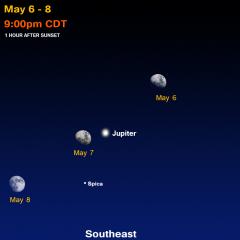
Jupiter rules the night skies this May. After sunset, look for the King Planet shining brightly halfway up the southeast sky. A waxing gibbous Moon rolls through from May 6-8.
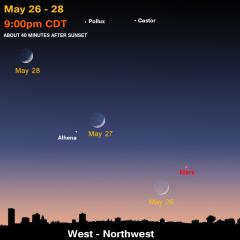
Mars gets tougher to see each night low in the WNW sky. By May 31, it sets only a little more than an hour after sunset. When it disappears completely in mid-June, the Red Planet will be gone the entire summer. A crescent Moon may help you find Mars on May 26-28.
Saturn becomes more accessible to evening stargazers this month. On May 1, it rises about 11:30pm; by May 31, it rises around 9:30pm. The Moon shines close by on the nights of May 12-13.
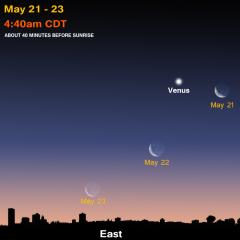
Venus is unmistakable in the morning sky, rising about two hours before the Sun. Look for the Moon shining nearby on May 21-23.
Mercury is hard to spot once again, but dedicated early birds may see it very low in the east 30 minutes before sunrise.
Star Map
 Download the May Star Map.
Download the May Star Map.
Sign Up
See the Universe through a telescope! Join one of the Milwaukee-area astronomy clubs and spot craters on the Moon, the rings of Saturn, the moons of Jupiter, and much more.
Send an e-mail to Planetarium Director Bob Bonadurer at bonadurer@mpm.edu and place 'subscribe' in the subject line to receive the Starry Messenger and monthly star map.
![]() Follow Bob on Twitter @MPMPlanetarium.
Follow Bob on Twitter @MPMPlanetarium.


